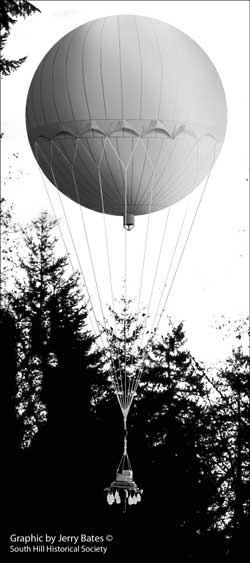Balloon Bombs of 1945
by Carl Vest
 Seventy years ago the community of South Hill was introduced into World War II in a most violent way. It was in March 1945 when a Japanese aerial attack targeted South Hill. There were two impact points.
Seventy years ago the community of South Hill was introduced into World War II in a most violent way. It was in March 1945 when a Japanese aerial attack targeted South Hill. There were two impact points.
The weapon used was code named FuGo, for an unmanned balloon bomb. The Japanese had researched balloon weapons since the 1930s but it was not until World War II that the idea became well-defined. Also, some way was needed to expand their offensive and to bring WWII to the North American continent. In the 1940s there was no practical way for the Japanese to grasp that far. Long range bombers didn’t have the reach. Intercontinental missiles had not been invented. Explosive devices that could be carried in submarines and released close to the United States coastline were considered but never actually used. And as part of their research, the Japanese explored various meteorological phenomena that were known to exist across the North Pacific. From this latter work authorities decided to deliver bombs by making use of that large river of air that flows west to east across the upper atmosphere — today we call it the jet-stream.
The balloons were made of paper. The final design was a vehicle consisting of four layers of thin long-fiber paper, 100 feet in circumference (32.8 feet in diameter), and each with a gas volume (hydrogen) of 19,000 cubic feet. Production began in 1944 and the first send-up took place in November 1944. The attacks continued to mid-1945 with an estimated 9,300 weapons launched. All were fired from the Japanese main island of Honshu, with about three days required for the transit across the Pacific Ocean. Each carried a payload of explosives.
Official records show that 25 bombs hit Washington State during the Japanese campaign. This number is probably not accurate. For example, only one bomb is recorded as hitting South Hill, but there is evidence that the community experienced at least two strikes.
One balloon landed just off 94th Avenue on South Hill, about where the Mormon Church is now located (near Rogers High School). It exploded but there were no injuries. This happened on March 5, 1945. Joan (Parks) Vosler who was a teenager at the time, living in the area, remembers that the local people could not go near the blast site. She recalls that her brother tried to climb over a barrier and got into trouble for his effort. Joan still lives within sight of the explosion spot.
Earlier, on March 1, 1945 another balloon had landed further south, near where Pierce County Airport is now located. It did not explode. Rather it became lodged in a tree on the farm of Charles Massie. Mr. Massie pulled the balloon free and cut it into pieces. He gave the samples to his children for keepsakes. His son, Arthur Massie, exhibited his memento several times at local meetings before his death. It remains with the Massie family.
Carl Vest, PhD, is a founding member and Research Director for the South Hill Historical Society.